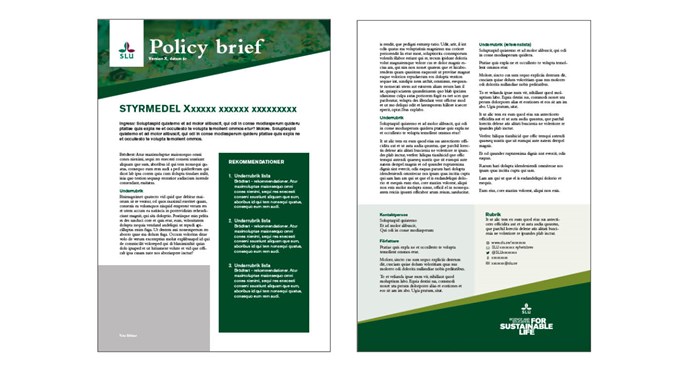A policy brief contains politically neutral recommendations on a topic, aimed at decision-makers and compiled by knowledgeable researchers and packaged in an easily accessible format.
What is a policy brief?
A policy brief contains politically neutral recommendations on a topic. It is aimed at decision-makers, compiled by knowledgeable researchers and packaged in an easily accessible format.
The purpose of science for policy is to contribute to important decisions being made on a scientific basis, and to contribute to change processes in society by, together with researchers, producing scientifically substantiated recommendations to decision-makers, summarised in policy briefs.
Strengths
- Policy briefs present scientifically substantiated recommendations on policy-relevant issues important to societal development. A policy brief is not a fact sheet (it contains recommendations), but neither is it an op-ed (it does not contain personal opinions).
- Decision-makers at all levels appreciate both the short format and the fact that conclusions have already been drawn based on current research.
- Policy briefs are easily accessible and highlight research findings presented in longer reports and scientific articles.
Target groups
Decision-makers involved in decisions related to food at all levels of society, e.g. politicians, authorities, food system actors and funders.
Important points
The researchers are the senders of a policy brief as they are the ones that contribute their expertise. Those writing policy briefs help make the content easily accessible and also guarantee that the content is reliable.
Before creating a policy brief, always make sure that there is no conflict of interest that may affect the policy brief. For example, do any of the researchers involved have a secondary employment? If yes, has it been approved by SLU?
There is a cultural difference between research and politics - the text should be written as a popular science text, call to action but not lecture. It should produce feelings of credibility and hope.
One difficulty is the balance between science and values. It is important that the recommendations in a policy brief are thoroughly grounded in research and as value-neutral as possible.
The text must be sent for consultation to the staff of SLU Future Food, to at least one colleague, and preferably to the SLU Future Food steering group. The heads of department concerned should be informed when a policy brief is being prepared.
Content
- 4 A4 pages, created using the template.
- The title should be short, concise, reflect the subject and call for action.
- The preamble should summarise the content, 300–400 characters including spaces.
- The policy brief usually contains 3-5 recommendations, but there may be more. They are based on the current situation and can be updated in a later edition. Several different decisions can be proposed. About 1000 characters including spaces.
- The main text begins with a brief introduction to the subject at a popular-science level. This is followed by sections where each of the recommendations is explained in more detail. About 10,000 characters including spaces.
- The reference list is important to show that the recommendations are scientifically sound.
- The policy brief contains a list of the researchers behind the content and contact information for at least one of them, as well as for the department/division they belong to.
- Images, and possibly information graphics, should reflect the content and be visually appealing.
